By Wendy Sheppard
How a quilt is quilted often determines its final appearance, thus the saying “the quilting makes the quilt.” Working with students in classes, I have met many who are frustrated at not knowing what and how to quilt their quilts. Use these simple strategies I have developed for block quilting with your home sewing machine to transform frustration into elation in your next quilted masterpiece.
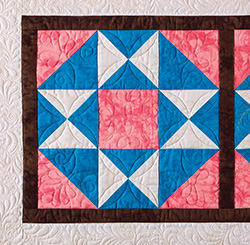
Using simple geometric and symmetrical motifs emphasizes the piecing of a quilt block.
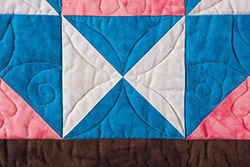
When deciding how to go about quilting my quilts, I ask myself the following: Do I want to–
• emphasize the designs of the pieced blocks that make up the quilt (referred to herein as “block makeup”),
• create the effect of an overall texture, or
• create an attractive texture that also highlights the piecing?
Quilting Within the Patches
Quilting mostly within the confines of individual patches of a pieced block with simple, geometric, and symmetrical motifs draws the eye to the makeup of the block (Photos 1 and 2). This approach to quilting is perfect for highlighting either simple or complicated piecing in your quilt.
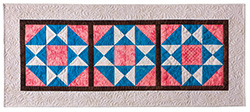
Check your collection of quilting stencils for simple motifs to use to emphasize the block makeup. Don’t worry if you do not have a stash of quilting stencils to choose from; your local quilt shop should carry stencils or books with quilting motifs. The public library may also have books of designs. There are also numerous online sources for quilting stencils. Common household items also make great templates.
When quilting within the patches of a quilt block, start by stitching “in the ditch” along all of the parallel and perpendicular lines within the block. This stitching defines the block makeup and stabilizes the blocks. I use monofilament thread for this step to create “invisible” stitches. Proceed with quilting the other selected motifs to emphasize the individual patches.
All-over Quilting (Quilting Beyond the Piecing)
This second approach to quilting tends to blur the lines between the quilting and the piecing—the block makeup tends to recede with all-over quilting, especially if the quilting is dense (Photos 3 and 4). When one looks at a quilt block that is quilted with an all-over motif, the quilting and the quilt block read as “one.”
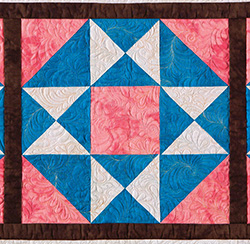
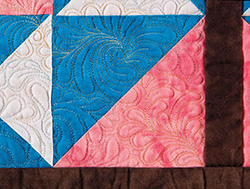
When used over the entire quilt an all-over motif creates a uniformly quilted texture. All-over quilting is highly conducive to unmarked free-motion quilting (as I did in the sample quilt) however; it can also be done by marking your quilt in full or part.
I like to do all-over quilting for a quilt made with busy fabrics. However, even if the fabrics are not busy, as in the sample, all-over quilting works just as well! Sometimes, you might even find an all-over quilting motif already decided for you in one of the printed fabrics in your quilt. Using a motif inspired by a print works well for blocks with large patches, like those found in snowball blocks, for example.
To do all-over quilting, I normally start by stitching in the ditch along the outer perimeter of the blocks to “set” the design, again using mono-filament thread. I generally do not stitch in the ditch along the patches of a block for an area that is 12″ square or less. Use multicolored thread when stitching an all-over motif to add interest to the design.
Quilting Beyond Patches, But Within the Block
This approach to quilting is slightly different from all-over quilting in that the quilting does not blend in as much with the block makeup. The quilt motif chosen should encompass the majority of the block, and not be limited by the boundaries of the individual patches of the block (Photos 5 and 6).
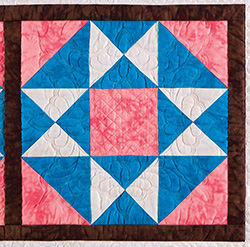

For this approach, I also only quilt in the ditches along the outer perimeter of the blocks unless the blocks are larger than 12″ finished.
Large quilting motifs from any quilting stencils work well for this approach to quilting. I personally like to use symmetrical feather quilting motifs for this combined technique—the feathers present a nice texture that doesn’t overwhelm the prominence of the block makeup. I like the symmetry of the quilting motifs to complement the symmetry of the block makeup. Straight stitching in the center of a symmetrical design provides an interesting contrast to the curved stitch lines. This mix of straight and curved lines also works to highlight the block makeup.
Other Universal Quilting Tips
Mark on the quilt top where necessary prior to basting the quilt sandwich. Use your stencil or template and your favorite marking tools to mark your design.
Using a fine thread as the top threads with a slightly shorter stitch length for free-motion quilting is a wonderful combination for quilters who are new to free-motion quilting. Matching thread color to the fabric color is conducive in masking mistakes. Once you are more confident in moving your quilts while you free-motion quilt, experiment with contrasting thread colors and other types of threads (rayon, metallic, etc.) to find your own customized combinations.
Home machine quilters might consider using lighter-weight batts to reduce the overall weight and drag of quilt sandwiches. I can more easily maneuver my quilts using wool or silk batting under the small throat area of my domestic home machine. Finally, practice, practice, practice. Over time, your quilting skills will improve.
Block Quilting Conclusion
Making a three-block quilting sampler, such as the one that accompanies this article is a great way to try out the three approaches to quilting traditionally pieced blocks. Try experimenting with different fabrics, threads and batting to find the combinations that work best for you. I hope the techniques I have shared will help you to decide how to successfully quilt your next pieced top.




